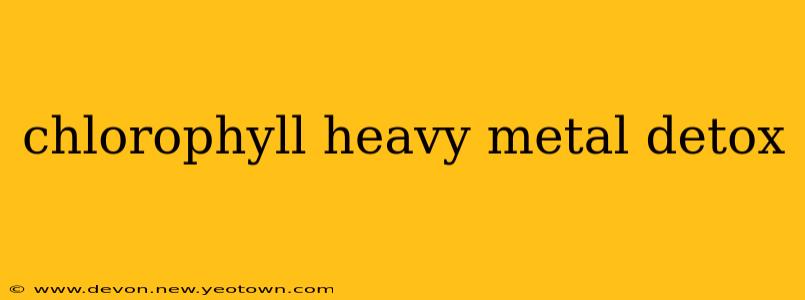The vibrant green of chlorophyll, the pigment responsible for photosynthesis in plants, has captivated humanity for centuries. Beyond its role in fueling plant life, chlorophyll has increasingly garnered attention for its potential health benefits, including its purported ability to aid in heavy metal detoxification. But is this claim backed by science, or is it just another wellness trend? Let's delve into the fascinating world of chlorophyll and its relationship with heavy metals.
My journey into researching chlorophyll's detoxifying properties began with a simple question: could something as natural and ubiquitous as chlorophyll truly help rid the body of harmful heavy metals? My initial skepticism gradually gave way to intrigue as I uncovered a wealth of information, both anecdotal and scientific. This article aims to provide a comprehensive overview, exploring the evidence, addressing common concerns, and separating fact from fiction.
Does Chlorophyll Help with Heavy Metal Detoxification?
The idea that chlorophyll can help detoxify heavy metals hinges on its molecular structure. Chlorophyll’s chemical makeup shares similarities with heme, a component of hemoglobin in our blood. This structural similarity suggests a potential mechanism: chlorophyll might bind to heavy metals in a similar way to how heme binds to oxygen, facilitating their removal from the body.
While intriguing, the evidence supporting this mechanism remains largely anecdotal and based on in-vitro studies (laboratory studies using cells or tissues). There's a lack of robust, large-scale human clinical trials definitively proving chlorophyll's effectiveness in heavy metal detoxification.
What are the Potential Benefits of Chlorophyll for Heavy Metal Detox?
While definitive clinical trials are lacking, some studies suggest potential benefits. These often focus on chlorophyll's ability to bind to certain heavy metals, facilitating their excretion. However, it's crucial to understand that the effectiveness can vary depending on the type of heavy metal, the dosage of chlorophyll, and individual factors.
How Does Chlorophyll Work in Heavy Metal Detox? (Mechanism of Action)
The proposed mechanism involves chlorophyll molecules binding to heavy metal ions in the digestive tract. This binding prevents the metals from being absorbed into the bloodstream and facilitates their elimination through the stool. This action is thought to be particularly effective for certain metals, though more research is needed to pinpoint specifics.
What are the Different Types of Chlorophyll?
Several types of chlorophyll exist, each with slightly different chemical structures and potential properties. The most common types found in supplements are chlorophyllin (a water-soluble derivative of chlorophyll) and chlorophyll a and b. The effectiveness of each type in heavy metal detoxification requires further investigation.
What are the Side Effects of Chlorophyll?
Generally, chlorophyll is considered safe for consumption. However, some individuals may experience mild side effects such as:
- Green-colored stool: This is a common and harmless side effect.
- Mild digestive upset: This is usually temporary and resolves quickly.
More significant side effects are rare, but it's always wise to consult a healthcare professional before starting any new supplement regimen, especially if you have pre-existing health conditions.
Is Chlorophyll a Miracle Cure for Heavy Metal Toxicity?
No, chlorophyll is not a miracle cure for heavy metal toxicity. It should not be considered a replacement for conventional medical treatments for severe heavy metal poisoning. Severe heavy metal poisoning requires medical intervention, such as chelation therapy. Chlorophyll may play a supportive role, but it’s crucial to consult a doctor for diagnosis and treatment of heavy metal toxicity.
What are Other Ways to Detoxify Heavy Metals?
Heavy metal detoxification involves various approaches, often tailored to the specific metal and severity of toxicity. Methods may include:
- Chelation therapy: This medically supervised procedure uses specific agents to bind and remove heavy metals from the body.
- Dietary changes: A diet rich in fiber and certain nutrients can support the body's natural detoxification processes.
- Lifestyle modifications: Reducing exposure to heavy metals through environmental changes is crucial.
Conclusion: A Promising Area of Research
While the evidence supporting chlorophyll's role in heavy metal detoxification isn't conclusive yet, the potential is intriguing. Ongoing research is crucial to solidify the understanding of chlorophyll's mechanism and its effectiveness in different scenarios. For now, it's best to view chlorophyll as a potentially supportive element in a holistic approach to wellness, not a standalone solution for heavy metal toxicity. Always consult your healthcare provider before using chlorophyll or any other supplement for detoxification purposes.

